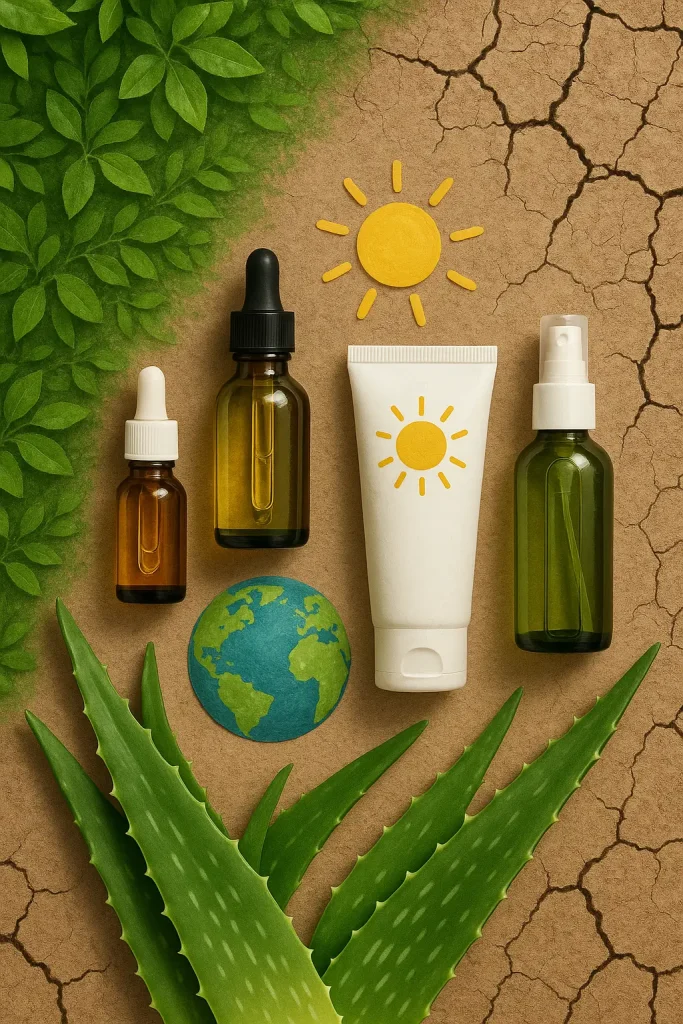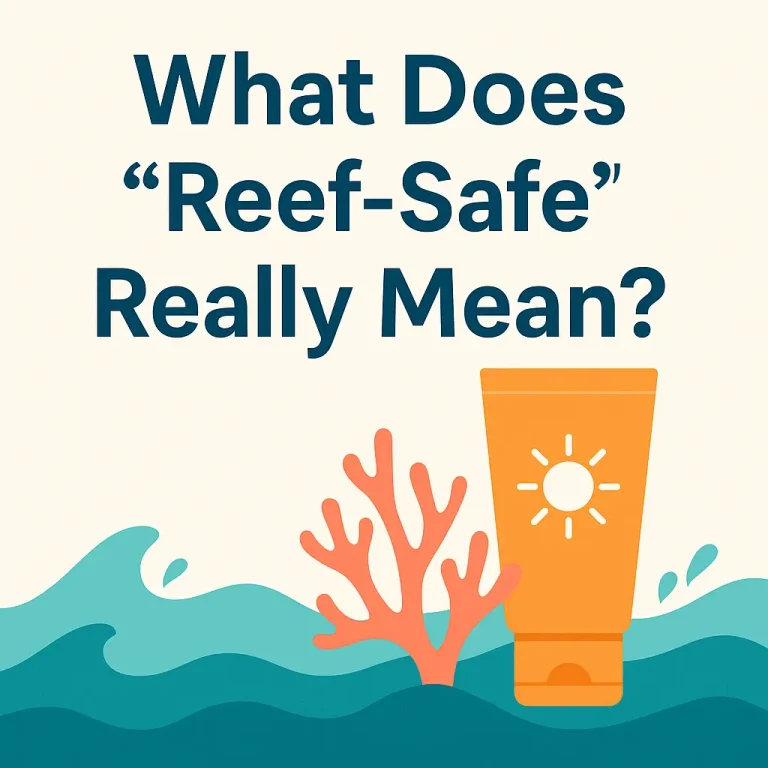Climate Change and Skin Care: Understanding Environmental Risks
When it comes to climate change and skin care, the connection is more personal than you might think. Have you ever noticed your skin reacting differently during heat waves or sudden weather shifts? Maybe your face feels oilier after a stretch of humid days, or dry patches of skin pop up when the air pollution index climbs. I know I have—and if you’re reading this, I bet you have too. Our skin, the body’s largest organ, is more sensitive to environmental factors than we sometimes realize. And in a changing climate, those shifts are happening faster and more dramatically than ever before.
Climate change and skin care isn’t just a headline—it’s something we feel on our faces (literally) every single day. Higher temperatures, unpredictable weather events, and air pollution can all impact skin health, causing everything from itchy skin and flare-ups of eczema to premature aging and increased skin cancer risk. As a skin care nerd who’s lived through a few “climate plot twists,” I can promise you: the effects of climate change on skin are real, and they’re not going away.
But here’s the good news: You absolutely can adapt. In this post, you’ll find science-backed tips, dermatologist insights, and easy, eco-friendly ways to protect your skin in a warming world. Whether you have sensitive, resilient, or somewhere-in-between skin, you’ll discover practical swaps and gentle routines that support both your skin’s health and the health of our planet.
Ready? Let’s dive in—and see how a little knowledge (and a lot of SPF) can help future-proof your skin care for whatever climate comes next.

How Climate Change and Skin Care Interact in Everyday Life
Here’s the thing: climate change isn’t just about rising sea levels and polar bears—it’s also about what’s happening on the surface of your own skin, every single day.
Heatwaves, UV radiation, and air pollution are no longer rare events; they’re the new normal. According to recent studies, including The Impact of Climate Change on Skin (PubMed), our skin is increasingly exposed to environmental stressors like drought, humidity swings, and spikes in pollution. These factors don’t just sound intimidating—they actually change how your skin looks, feels, and behaves.
So, what does science say?
- Heatwaves can dehydrate the skin, leading to more visible fine lines, flakiness, and an overall feeling of “tight” or itchy skin.
- UV radiation is stronger and lasts longer, increasing the risk of sunburn and skin cancer, as well as accelerating skin aging.
- Air pollution—think smog, wildfire smoke, and city haze—introduces free radicals and tiny particles that can irritate the skin, worsen eczema, and weaken your skin barrier.
- Sudden humidity shifts (hello, sticky summers and bone-dry winters) can mess with your skin’s hydration, causing both dry patches and oily flare-ups.
- Drought and water scarcity don’t just affect plants—less moisture in the air means less comfort for sensitive or already dry skin.
Scientific reviews like Climate Change and Skin: Challenges and Perspectives and Skin Health and Global Environmental Change point out that these stressors can impact everyone, but especially those with sensitive or pre-existing skin conditions like eczema, dermatitis, or psoriasis. Even so-called “resilient” skin can start to show new issues—think redness, acne, or just a general sense that your skin isn’t as happy as it used to be.
Environmental Factors and Skin Aging (PubMed) confirms that all these changes speed up oxidative stress and premature aging, while also increasing the risk of inflammatory skin conditions.
What does this mean for you?
You might notice:
- Skin that feels drier or oilier than usual
- Unexpected breakouts or patches of eczema
- A loss of “bounce” or healthy glow
- Flare-ups of conditions you thought you had under control
No matter your skin type, the effects of climate change are showing up in our daily routines—and our mirrors. But the good news? You can absolutely adapt your skincare to meet the moment.
If you’d like to read more on how climate change impacts the health of your skin (plus expert tips), I recommend this helpful article on Healthline: How Climate Change Can Impact the Health of Your Skin.

Why Your Skincare Routine Needs to Evolve
Here’s the honest truth: that skincare routine you swore by five years ago? It might not cut it anymore. Our world—and our climate—is changing fast, and your skin feels every shift, even before you do.
Think about how your skin reacts when you travel to a new city, spend more time in air-conditioned rooms, or get caught in a surprise heatwave. The reason is simple: microclimate matters. Every new spike in temperature, jump in humidity, or bout of air pollution creates a new challenge for your skin barrier. The impact of climate change is literally in the air (and on your face).
Old routines, new world:
- Barrier creams and rich moisturizers that worked in cooler weather might feel greasy during a heatwave.
- Your favorite exfoliant may suddenly irritate the skin when UV radiation and pollutant exposure are up.
- If you live in a city, rising air pollution can trigger more breakouts and make inflammatory skin conditions like eczema or psoriasis worse.
So, how do you know it’s time to change things up?
- Your skin feels dry in the morning and oily by the afternoon.
- You’re seeing new skin issues—think unexpected redness, itchiness, or flare-ups.
- Products that once felt soothing now sting or cause irritation.
- You just feel like your skin isn’t as healthy or “resilient” as it used to be.
Even dermatologists agree: maintaining skin health now means being flexible and listening to what your skin is telling you. The “set it and forget it” approach? It’s officially out. Today, the best skin care is the one that adapts with you and the climate.
Eco-Friendly Skin Care Strategies for a Warming World
Alright, let’s get practical. If climate change is here to stay (and all signs point to yes), the smartest thing you can do is adapt your routine—and do it in a way that’s gentle on both your skin and the planet.
Here’s what actually works, according to both dermatology research and real-life experience:
1. SPF Every Day (No Matter the Weather)
UV radiation is stronger and sneakier in a warming climate. Even on cloudy days, your skin is exposed to ultraviolet radiation that can trigger sunburn, accelerate skin aging, and increase your risk of skin cancer. Go for mineral sunscreen (like zinc oxide or titanium dioxide)—it’s effective, reef-safe, and less likely to irritate the skin. (Watch this space for a full guide to mineral sunscreens coming soon!)
2. Support Your Skin Barrier
When your skin barrier is under attack from air pollution, extreme weather, or higher temperatures, it needs extra TLC.
- Look for ceramides, plant oils (like jojoba or squalane), and antioxidants such as vitamin E or green tea extract.
- Prioritize hydration—mists, lightweight gels, and hyaluronic acid serums can keep your skin feeling balanced without clogging pores.
3. Gentle Cleansing Is Key
With increased exposure to pollutants and sweat, harsh cleansers can do more harm than good.
- Choose fragrance-free, non-stripping formulas.
- If you love double cleansing, keep it extra gentle in summer or during heatwaves to avoid stripping away your natural oils.
4. Cooling & Soothing Botanicals
Heat, pollution, and sun exposure can irritate the skin and worsen inflammatory skin conditions like eczema and dermatitis.
- Reach for natural soothers like aloe vera, chamomile, cucumber, or green tea.
- Store your favorite toner or mist in the fridge for an instant, cooling refresh.
5. Go Easy on Exfoliation
Strong acids and scrubs can exacerbate irritation, especially during hot, humid spells.
- Cut back to once a week or switch to gentler formulas.
- Watch for signs your skin barrier needs a break—redness, stinging, or extra dryness.

DIY and Eco-Friendly Swaps
- Herbal Macerates & Hydrosols: Swap synthetic toners for homemade herbal waters or chamomile hydrosol. They’re gentle, effective, and low waste.
- Natural Oils: Lightweight, non-comedogenic oils (like squalane, jojoba, or raspberry seed) strengthen your skin barrier and help lock in hydration—no microplastics, no nasties.
- Sustainable Packaging: Look for refillable bottles, solid cleansers, and brands that skip single-use plastic. Bonus: Glass dropper bottles look great on your shelf.
- Cruelty-Free Choices: A warming world needs kinder choices all around. Choose brands that are transparent about ingredients and ethics.
Quick Swaps for Hotter Days
- Trade heavy creams for lightweight lotions or hydrating gels.
- Opt for mineral SPF over chemical filters—safer for you, safer for oceans.
- Keep a thermal water mist in your bag for on-the-go relief.
- Switch to cleansing milks or micellar water if your skin feels stripped.
Making even one or two of these swaps can help soothe skin and support its natural resilience, all while shrinking your beauty carbon footprint. And let’s be honest: less waste, more glow? Yes, please.
How to Future-Proof Your Summer Skin Care
Let’s talk about your next summer move—because this changing climate isn’t taking a vacation. If you want your skin to thrive (not just survive) in the hottest months, there’s one upgrade you don’t want to skip: mineral sunscreen.
Why does mineral SPF matter now more than ever?
With stronger UV radiation, ozone changes, and more frequent heat waves, your skin is exposed to risks that go way beyond a little sunburn. The right sunscreen doesn’t just protect against UV radiation and sunburn; it helps prevent premature aging and even reduces the risk of skin cancer, especially when used daily and applied generously.
Here’s the eco-friendly twist:
Mineral sunscreens—think zinc oxide and titanium dioxide—are non-nano, reef-safe, and gentle on sensitive skin. They form a physical barrier that bounces away both UVA and UVB rays. Unlike many chemical filters, they’re less likely to trigger allergic reactions or irritate the skin, making them a smart choice in a warming world. Plus, they don’t harm marine life, so you can enjoy that dip in the ocean guilt-free.
Coming up next:
I’ll be sharing a full post all about choosing the best mineral sunscreens for every skin type—including tips on application, texture, and eco-conscious packaging. Your skin (and the planet) will thank you.
Frequently Asked Questions
1. How does air pollution affect my skin?
Air pollution exposes your skin to tiny particles and pollutants that can irritate the skin barrier and lead to dryness, redness, and even more breakouts. Over time, it can accelerate premature skin aging and make existing skin conditions like eczema or dermatitis feel worse.
Tip: Gentle cleansing at night and using antioxidant-rich serums can help your skin fight back.
Explore natural calming ingredients here.
2. Which skin condition is most influenced by weather changes?
Eczema is often the first to react when humidity, temperature, or pollution shifts, but psoriasis, dermatitis, and even acne can flare up too. Pay attention to your skin’s mood swings—sometimes a simple routine tweak makes all the difference.
3. How can you protect your skin from the effects of climate change and skin care challenges?
Support your skin barrier with gentle, hydrating products, daily sun protection, and antioxidants. Skip harsh scrubs, and look for lightweight textures in hotter months. Eco-friendly choices also reduce the overall impact on your skin and the planet.
See our Summer Skincare Tips for inspiration.
4. Can environmental factors contribute to aging?
Definitely, things like UV radiation, pollution, and even rapid temperature swings create oxidative stress that leads to signs of premature aging—think fine lines, dullness, and loss of bounce. Prevention is everything: SPF, antioxidants, and keeping your routine gentle all help keep your glow.
5. Why is UV radiation harmful to my skin?
UV radiation can damage the skin barrier, accelerate visible aging, and make skin more reactive or sensitive. It also increases the risk of sunburn and can worsen conditions like pigmentation or dermatitis. That’s why year-round sun protection is your skin’s best friend—yes, even on cloudy days.
Conclusion
Here’s the truth: you don’t have to overhaul your entire routine to make a real difference for your skin—and the planet. Climate change and skin care are more closely connected than ever, and even small, thoughtful changes can make a significant difference.
Maybe it’s choosing a sunscreen that truly protects your skin against ultraviolet radiation, or simply tuning in to how humidity and weather patterns affect your skin’s hydration needs. Little things, like supporting your skin barrier with antioxidant-rich products, can help guard against free radicals and oxidative stress caused by exposure to air pollution and UV radiation.
And if you battle dry skin on your legs like I do, here’s a tip: try layering a hydrating mist or toner first, then apply a plant-based body oil or a rich, unscented cream while your skin is still damp. It’s a total game-changer for locking in moisture, especially during those dry, weather-shift days.
Remember, your skin is your body’s largest organ and its first line of defense. Strengthening your skin barrier and making eco-friendly swaps isn’t just about beauty—it’s about maintaining skin health and building resilience for the future.
Now I’d love to hear from you:
Have you noticed your skin changing with the weather or shifting climate? What’s your favorite way to keep your skin healthy and hydrated, especially on those unpredictable days? Drop a comment below—whether it’s a clever routine tweak, a hydration hack, or a sustainable swap you love. Your story might inspire someone else to protect their skin (and our world) in a warming climate.
For more practical guides and science-backed skin wisdom, check out:
- Summer Skincare Tips
- Cooling Herbs for Summer
- Sustainability in Beauty Rituals
- And stay tuned for our full guide to Best Mineral Sunscreens for Sensitive Skin (coming soon!)
Together, we can nurture healthy skin and a healthier planet. Every eco-friendly choice makes a difference.
Kristina






